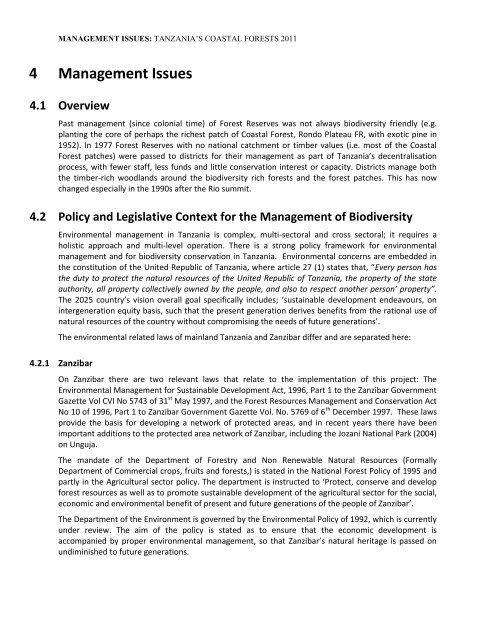Neil D. Burgess, Paul Harrison, Peter Sumbi, James Laizer, Adam ...
Neil D. Burgess, Paul Harrison, Peter Sumbi, James Laizer, Adam ...
Neil D. Burgess, Paul Harrison, Peter Sumbi, James Laizer, Adam ...
Create successful ePaper yourself
Turn your PDF publications into a flip-book with our unique Google optimized e-Paper software.
MANAGEMENT ISSUES: TANZANIA’S COASTAL FORESTS 2011<br />
4 Management Issues<br />
4.1 Overview<br />
Past management (since colonial time) of Forest Reserves was not always biodiversity friendly (e.g.<br />
planting the core of perhaps the richest patch of Coastal Forest, Rondo Plateau FR, with exotic pine in<br />
1952). In 1977 Forest Reserves with no national catchment or timber values (i.e. most of the Coastal<br />
Forest patches) were passed to districts for their management as part of Tanzania’s decentralisation<br />
process, with fewer staff, less funds and little conservation interest or capacity. Districts manage both<br />
the timber-rich woodlands around the biodiversity rich forests and the forest patches. This has now<br />
changed especially in the 1990s after the Rio summit.<br />
4.2 Policy and Legislative Context for the Management of Biodiversity<br />
Environmental management in Tanzania is complex, multi-sectoral and cross sectoral; it requires a<br />
holistic approach and multi-level operation. There is a strong policy framework for environmental<br />
management and for biodiversity conservation in Tanzania. Environmental concerns are embedded in<br />
the constitution of the United Republic of Tanzania, where article 27 (1) states that, “Every person has<br />
the duty to protect the natural resources of the United Republic of Tanzania, the property of the state<br />
authority, all property collectively owned by the people, and also to respect another person’ property”.<br />
The 2025 country’s vision overall goal specifically includes; ‘sustainable development endeavours, on<br />
intergeneration equity basis, such that the present generation derives benefits from the rational use of<br />
natural resources of the country without compromising the needs of future generations’.<br />
The environmental related laws of mainland Tanzania and Zanzibar differ and are separated here:<br />
4.2.1 Zanzibar<br />
On Zanzibar there are two relevant laws that relate to the implementation of this project: The<br />
Environmental Management for Sustainable Development Act, 1996, Part 1 to the Zanzibar Government<br />
Gazette Vol CVI No 5743 of 31 st May 1997, and the Forest Resources Management and Conservation Act<br />
No 10 of 1996, Part 1 to Zanzibar Government Gazette Vol. No. 5769 of 6 th December 1997. These laws<br />
provide the basis for developing a network of protected areas, and in recent years there have been<br />
important additions to the protected area network of Zanzibar, including the Jozani National Park (2004)<br />
on Unguja.<br />
The mandate of the Department of Forestry and Non Renewable Natural Resources (Formally<br />
Department of Commercial crops, fruits and forests,) is stated in the National Forest Policy of 1995 and<br />
partly in the Agricultural sector policy. The department is instructed to ‘Protect, conserve and develop<br />
forest resources as well as to promote sustainable development of the agricultural sector for the social,<br />
economic and environmental benefit of present and future generations of the people of Zanzibar’.<br />
The Department of the Environment is governed by the Environmental Policy of 1992, which is currently<br />
under review. The aim of the policy is stated as to ensure that the economic development is<br />
accompanied by proper environmental management, so that Zanzibar’s natural heritage is passed on<br />
undiminished to future generations.

















